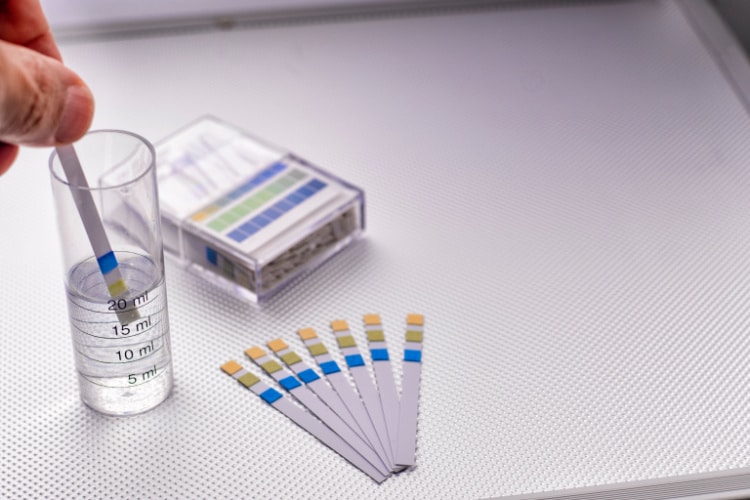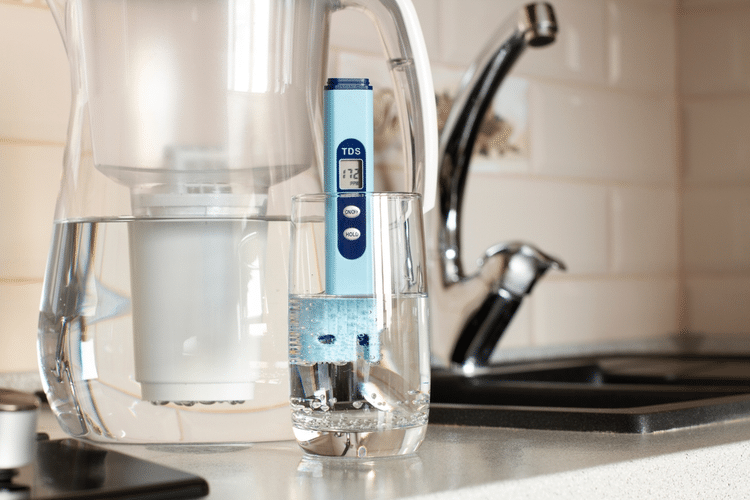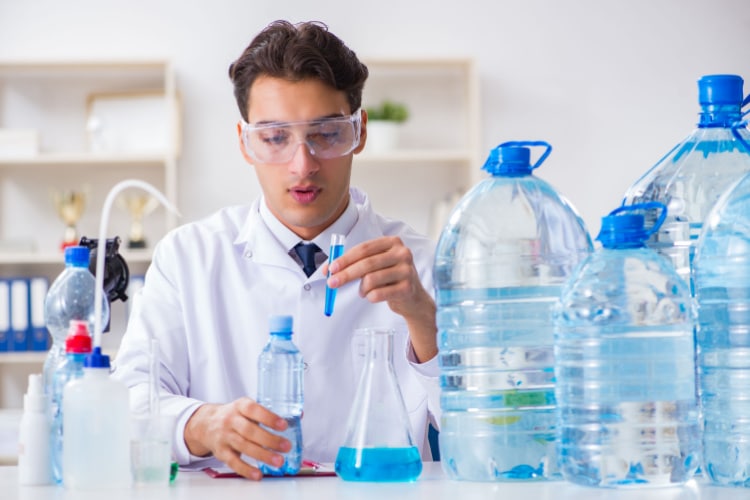If you want to test the pH level of your water, standard test strip kits you can find in pool supply shops and most pet shops are the norm.
However, if you can’t get your hands on these strips or don’t want to use them for one reason or another, there are several other methods you can use to test the pH level of your water.

Why Is the pH Level Important?
The pH level of water applies to the presence of hydrogen ions in water. But, to be more specific, the pH scale measures the ratio of two elements: hydrogen ions (H+) and hydroxide ions (OH-).
When these two elements are found in equal amounts, the water will have a neutral pH level of 7. The more hydrogen ions, the more alkaline the water is. Acidic solutions are those with a pH less than 7, while those above 7 are alkaline.
While pure water is neutral, other types of drinking water might be more acidic or alkaline, depending on their content. For instance, mineral water is alkaline thanks to the high concentrations of minerals.
That said, drinking water that’s too acidic or too alkaline isn’t good for your health. The ideal pH level for your drinking water, your soil, your swimming pool, and your fish tank is 7.0 (this also depends on the type of fish you keep).
Using or drinking very alkaline water isn’t advised. While it doesn’t pose any serious health risks unless you have an underlying condition, such as kidney disease, the high pH can upset your stomach or lead to dry and itchy skin if you use it topically, especially in people with sensitive skin.
The pH value also affects the behavior of chemicals in the water, which is why it’s also used to determine the number of chemicals you have in your swimming pool and whether or not you have too much chlorine or need to add more.
The Issue With Testing Strips
Water testing strips are incredibly easy to use, which is the primary reason why they’re so popular. But, unfortunately, they’re not precise, which is important if you’re testing the pH of your aquarium or water for gardening use.
The kit comes with a color grading scale and several colored strips. All you need to do to test the water is fill up a glass, dip a strip in the glass, and keep it there until it changes color.
Once the strip turns a certain color, match it to the color grading scale on the testing kit itself, and you’ll find the pH value associated with that color.
As we mentioned, this is super convenient, but the main problem is that it’s not all that accurate.
You can’t get decimal readings on these tests. So, if the pH value of your water is 6.5, you won’t be able to tell since the color value scale will show either 6 or 7. This might not seem like much of an issue, but properly adjusting the pH value of your water can make all the difference in whether your fish and your plants thrive or die.
The pH value of your pool, on the other hand, doesn’t need to be as precise, so if all you need to do is check the water before a swim, then the testing strips are a good, affordable option.
As for drinking water, you’ll want to keep it between 6.5 and 7.5. Precise measurements are preferred, but you can still use the strips unless you need to control the precise water pH levels due to a medical condition.
That being said, there are other completely free pH-level testing methods you can find online. Unfortunately, many of them are untrustworthy.
Untrustworthy pH Level Testing Methods
There are several homemade methods used to determine the pH value of water that have become popular online and are free or very cheap. However, compared to testing kits, these DIY methods are more difficult to set up, provide less accurate readings, and cost more money in the long run.
Some popular yet untrustworthy methods involve cabbage, dirt, and litmus paper. Here’s why you shouldn’t use them.
- The Cabbage Method: One of these popular DIY methods involves using cabbage to test the pH level of water. To do that, you chop up the cabbage, boil it, blend it, and strain it into a bowl. Then, you add some isopropyl alcohol to get the indicator solution you’ll be testing the water with. After this, you soak a piece of paper in the water until the color changes. You take the paper out and leave it on a clean towel overnight. The next day, you cut up the paper to get your testing strips. This testing option takes a lot of time to set up and prepare, the materials are not cheap, and the reading is unreliable.
- The Blue Berries Method: Blueberries get their dark blue color from the chemical peonidin. This chemical is pH-sensitive, and when dipped in a solution, the anthocyanidins lose their color and show a darker appearance if the water is alkaline. One drawback of this method is that it can be difficult to differentiate between the different shades, which makes it untrustworthy.
- The Red Onion Method: This method is based on the fact that many vegetables contain sensitive anthocyanins, which can change color in the presence of alkaline and acidic substances. Red onions also contain such chemicals, and when dipped in water, they can get a pale red color if the water is too acidic and green if it’s too alkaline. This is a cheap and convenient method, but very unreliable and imprecise. If successful, it may give a rough estimate of the pH level at best. But it doesn’t work unless the pH levels are too acidic or too alkaline, which is almost never the case with drinking water.
- The Litmus Paper Method: Another popular method for testing the pH level of water involves litmus paper. However, while this is cheaper than using testing strips, it’s less reliable since this paper can’t actually tell you the pH value of the water but only indicates if it’s alkaline or acidic.
In reality, there’s only one reliable method to test the pH value of your water with precision, and that’s by using a pH meter.
How to Use a pH Meter

The pH meter is a small hand-held device with a digital display that accurately determines the alkalinity or acidity of your water.
Compared to testing strips, these devices require more preparation before use, but the precise readings are definitely worth it.
Before you test your water, you need to calibrate your pH meter. Each manufacturer has different settings and requirements, but more often than not, you just need to punch in a few codes into the digital display so that the device can automatically start calibrating.
To double-check that it’s calibrated successfully, we recommend sticking the meter into water whose pH value you already know. Reverse osmosis bottled water[1] usually comes with a pH value on the label, so we’d suggest using that. If the reading on the label and the reading on the digital display align, you can start testing your water.
First, fill a glass with the water you want to test. Then, stick the meter in the glass and wait for a few seconds. Every manufacturer is different, but the average waiting time is 10 to 20 seconds.
The meter will either beep or start flashing to notify you that your reading is calculated, and you just need to look at the display to see what the pH value of the water is.
pH Meter Issues
There are three reasons why people don’t use pH meters: price, accessibility, and maintenance.
pH meters usually cost around $60 – $80, whereas testing strips cost around $20 for a full package (~50 strips). The price isn’t that steep, especially considering that you can reuse the device while the strips are single-use. However, people don’t need to test their water so frequently or accurately, which is why most will naturally gravitate toward the more cost-effective option.
Regarding accessibility, you can easily find a pH meter online, but they’re not as common in pool supply shops as the testing strips. Again, this isn’t much of an issue, but it means you’ll have to wait a few days until the meter is delivered before you can test your water.
Still, the main reason why people avoid pH meters is maintenance.
The pH meter needs to be washed with double-deionized water before you can use it again to get an accurate reading. The water isn’t that expensive, but you’ll need to make sure that you have some at hand every time you want to test your water.
The device must also be calibrated before every use, and the pH probe is very sensitive. These devices can be damaged or broken easily, even with very light pressure on the probe end. Therefore, you’ll need to be extra careful, or you’ll end up with no or inaccurate readings.
Water Testing Lab

We’d be remiss if we didn’t mention the most reliable and accurate method you can use to test the pH value of your water – sending a sample to a water testing lab.
These professional facilities can test the water for you if you send them a water sample in a closed and sterile plastic container marked with the tests you want to be performed.
The readings you’ll receive from a professional lab are the most reliable and accurate. However, the price will also be higher.
Water testing labs are great for discovering potential contaminants in your water that regular testing kits can’t pick up, so if you have other concerns you want to test your water for, a professional lab would be the perfect option. But, if you’re only looking for a pH level reading, this might not be the most sensible option.
Not only do these tests cost several hundred dollars, but they also take a few days or maybe even a week to process. On top of that, if you’re someone that needs frequent pH value checks for your garden or aquarium, then this isn’t a good option for you.
To be clear, using a water testing lab is, without a doubt, the most fool-proof method to find out the pH value of your water. However, the downsides far outweigh the upsides for repeated pH level testing.
Conclusion
The pH meter is the best testing method when it comes to determining the pH level of your water.
It’s a lot cheaper than a water testing lab, it’s more accurate than a test strip, and you can use it over and over again. The only real issue is the maintenance.
There are many DIY alternative testing methods you can easily find instructions for online, however, we do not recommend using them, as they don’t give accurate readings.
link to “Reverse Osmosis vs Distilled Water” when live